HONDA ACCORD SEDAN 2005 (in English) Workshop Manual
Manufacturer: HONDA, Model Year: 2005, Model line: ACCORD SEDAN, Model: HONDA ACCORD SEDAN 2005Pages: 302, PDF Size: 4.43 MB
Page 51 of 302
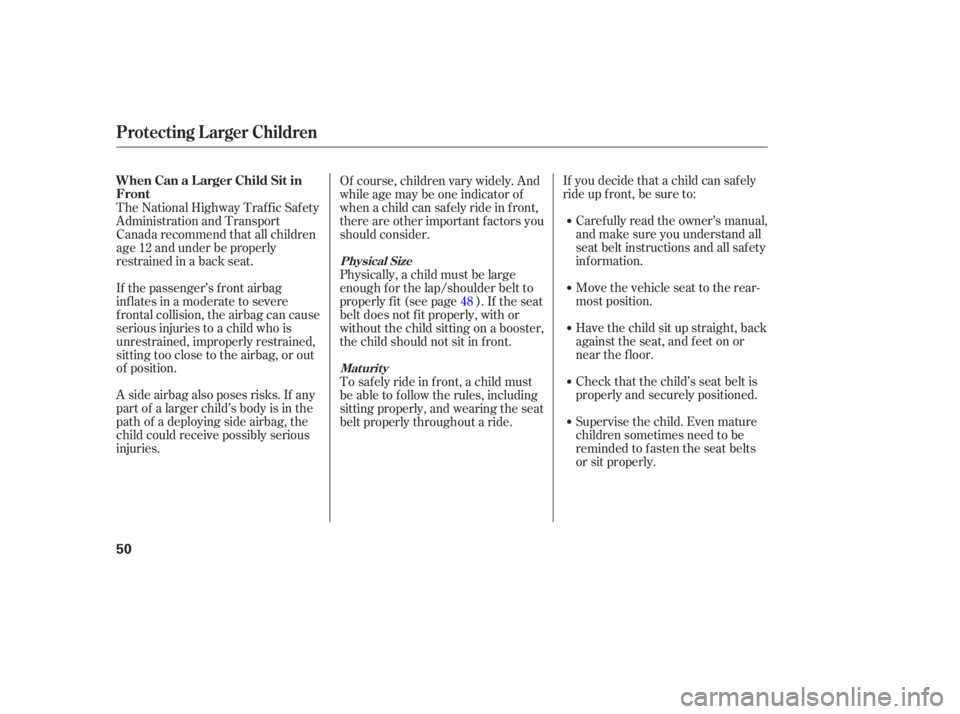
If you decide that a child can saf ely
ride up f ront, be sure to:Caref ully read the owner’s manual,
and make sure you understand all
seat belt instructions and all saf ety
inf ormation.
Move the vehicle seat to the rear-
most position.
Have the child sit up straight, back
against the seat, and feet on or
near the f loor.
Check that the child’s seat belt is
properly and securely positioned.
Supervise the child. Even mature
children sometimes need to be
reminded to f asten the seat belts
or sit properly.
Of course, children vary widely. And
while age may be one indicator of
when a child can saf ely ride in f ront,
there are other important f actors you
should consider.
If the passenger’s f ront airbag
inf lates in a moderate to severe
f rontal collision, the airbag can cause
serious injuries to a child who is
unrestrained, improperly restrained,
sitting too close to the airbag, or out
of position.
A side airbag also poses risks. If any
part of a larger child’s body is in the
path of a deploying side airbag, the
child could receive possibly serious
injuries. The National Highway Traffic Safety
Administration and Transport
Canada recommend that all children
age 12 and under be properly
restrained in a back seat. Physically, a child must be large
enough f or the lap/shoulder belt to
properly f it (see page ). If the seat
belt does not f it properly, with or
without the child sitting on a booster,
the child should not sit in f ront.
To saf ely ride in f ront, a child must
be able to f ollow the rules, including
sitting properly, and wearing the seat
belt properly throughout a ride.48
Protecting L arger Children
Physical Size
Maturity
When Can a L arger Child Sit in
Front
50
Page 52 of 302
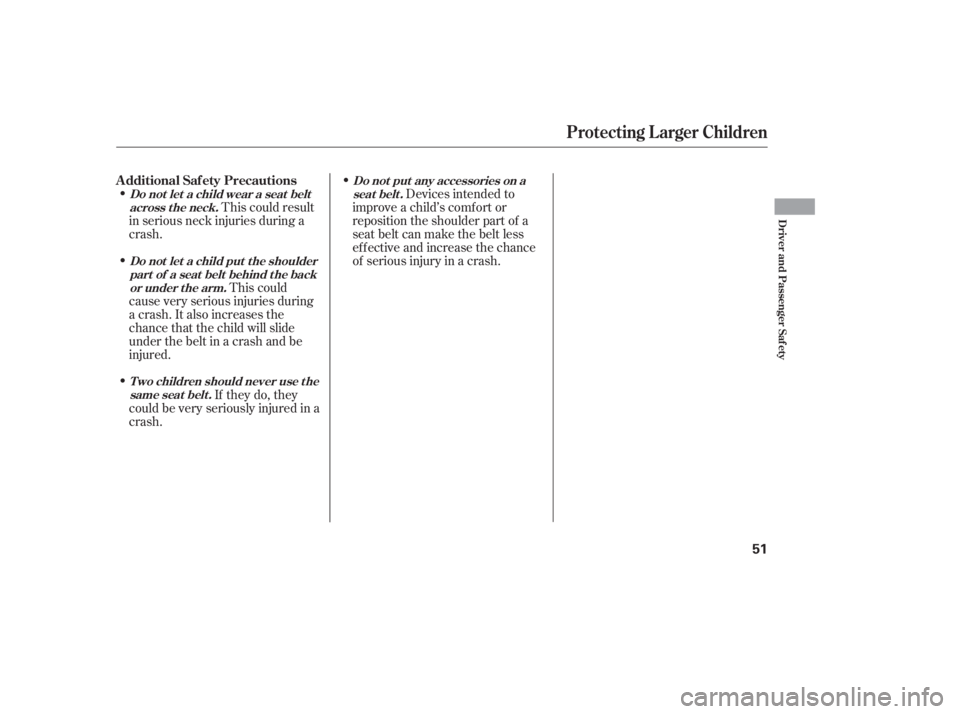
This could result
in serious neck injuries during a
crash. Devices intended to
improve a child’s comf ort or
reposition the shoulder part of a
seat belt can make the belt less
ef f ective and increase the chance
of serious injury in a crash.
This could
cause very serious injuries during
a crash. It also increases the
chance that the child will slide
under the belt in a crash and be
injured.
If they do, they
could be very seriously injured in a
crash.
Do not let a child wear a seat belt
across t he neck. Do not put any accessories on a
seat belt .
Do not let a child put the shoulder part of a seat belt behind t he backor under t he arm.
T wo children should never use t hesame seat belt .
Additional Saf ety Precautions
Protecting L arger Children
Driver and Passenger Saf ety
51
Page 53 of 302
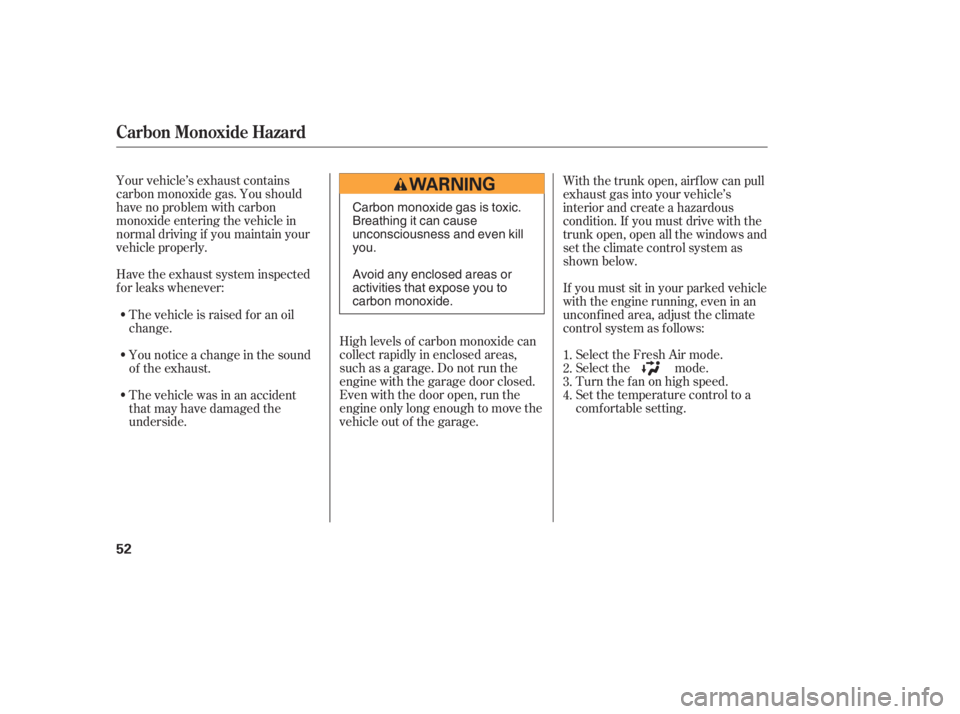
Your vehicle’s exhaust contains
carbon monoxide gas. You should
have no problem with carbon
monoxide entering the vehicle in
normal driving if you maintain your
vehicle properly.High levels of carbon monoxide can
collect rapidly in enclosed areas,
such as a garage. Do not run the
engine with the garage door closed.
Even with the door open, run the
engine only long enough to move the
vehicle out of the garage.
Have the exhaust system inspected
f or leaks whenever:
With the trunk open, airf low can pull
exhaust gas into your vehicle’s
interior and create a hazardous
condition. If you must drive with the
trunk open, open all the windows and
set the climate control system as
shown below.
If you must sit in your parked vehicle
with the engine running, even in an
unconfined area, adjust the climate
control system as f ollows:
Select the Fresh Air mode.
Select the mode.
Turn the f an on high speed.
Set the temperature control to a
comfortable setting.
The vehicle is raised f or an oil
change.
You notice a change in the sound
of the exhaust.
The vehicle was in an accident
that may have damaged the
underside.
1.
2.
3.
4.
Carbon Monoxide Hazard
52
Carbon monoxide gas is toxic.
Breathing it can cause
unconsciousness and even kill
you.
Avoid any enclosed areas or
activities that expose you to
carbon monoxide.
Page 54 of 302
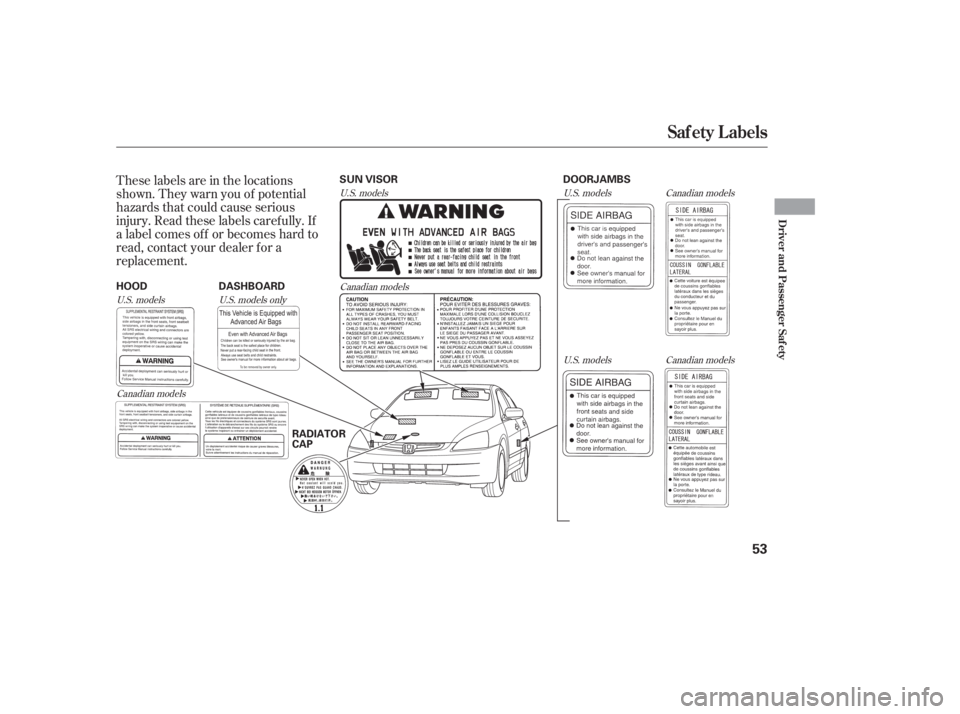
These labels are in the locations
shown. They warn you of potential
hazards that could cause serious
injury. Read these labels caref ully. If
a label comes of f or becomes hard to
read, contact your dealer f or a
replacement.U.S. modelsCanadian models U.S. models
Canadian models
U.S. models Canadian models
U.S. models
Canadian models U.S. models only
Saf ety L abels
Driver and Passenger Saf ety
53
SUN VISOR
HOOD DOORJAMBS
RADIATOR
CAP
DASHBOARD
Page 55 of 302

54
Page 56 of 302
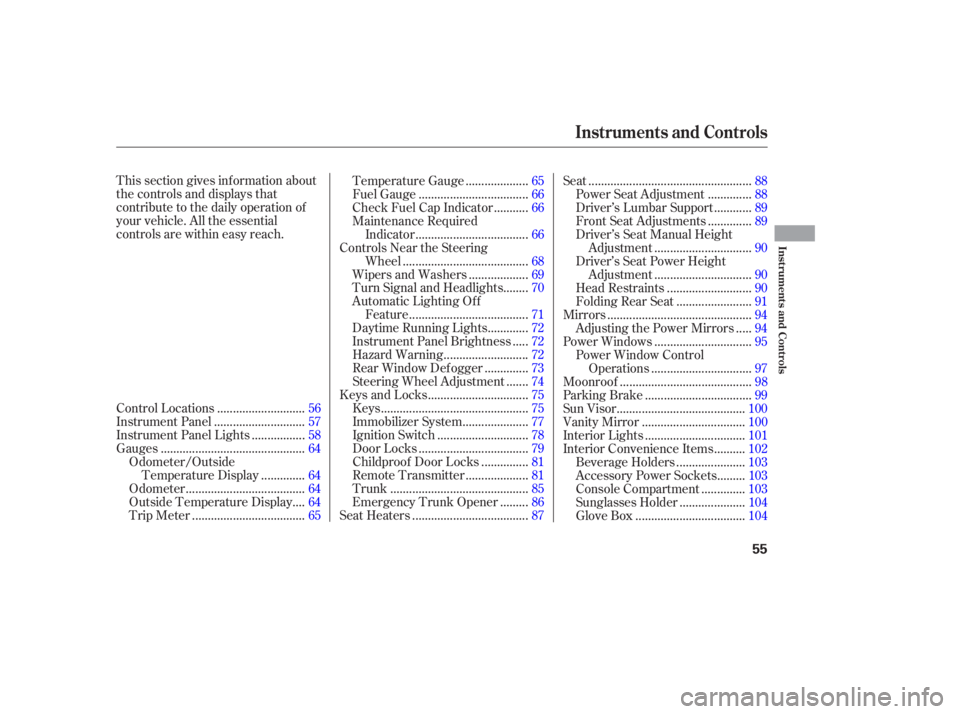
This section gives inf ormation about
the controls and displays that
contribute to the daily operation of
your vehicle. All the essential
controls are within easy reach............................
Control Locations .56
............................
Instrument Panel .57
................
Instrument Panel Lights . 58
.............................................
Gauges .64
Odometer/Outside .............
Temperature Display . 64
.....................................
Odometer .64
...
Outside Temperature Display . 64
...................................
Trip Meter .65 ...................
Temperature Gauge . 65
..................................
Fuel Gauge .66
..........
Check Fuel Cap Indicator . 66
Maintenance Required ...................................
Indicator .66
Controls Near the Steering .......................................
Wheel .68
..................
Wipers and Washers . 69
.......
Turn Signal and Headlights . 70
Automatic Lighting Off .....................................
Feature .71
............
Daytime Running Lights . 72
....
Instrument Panel Brightness . 72
..........................
Hazard Warning .72
.............
Rear Window Def ogger . 73
......
Steering Wheel Adjustment . 74
...............................
Keys and Locks .75
..............................................
Keys .75
....................
Immobilizer System . 77
............................
Ignition Switch .78
..................................
Door Locks .79
..............
Childproof Door Locks . 81
...................
Remote Transmitter . 81
...........................................
Trunk .85
........
Emergency Trunk Opener . 86
....................................
Seat Heaters .87 ...................................................
Seat .88
.............
Power Seat Adjustment . 88
...........
Driver’s Lumbar Support . 89
.............
Front Seat Adjustments . 89
Driver’s Seat Manual Height ..............................
Adjustment .90
Driver’s Seat Power Height ..............................
Adjustment .90
..........................
Head Restraints .90
.......................
Folding Rear Seat .91
.............................................
Mirrors .94
....
Adjusting the Power Mirrors . 94
..............................
Power Windows .95
Power Window Control ...............................
Operations .97
.........................................
Moonroof .98
.................................
Parking Brake .99
........................................
Sun Visor .100
................................
Vanity Mirror .100
...............................
Interior Lights .101
.........
Interior Convenience Items . 102
.....................
Beverage Holders .103
........
Accessory Power Sockets . 103
.............
Console Compartment . 103
....................
Sunglasses Holder .104
..................................
Glove Box .104
Instruments and Controls
Inst rument s and Cont rols
55
Page 57 of 302

Control L ocations
56
POWER DOOR LOCK
SWITCHES
POWER WINDOW
SWITCHESMIRROR CONTROLS
ACCESSORY POWER SOCKETSAUDIO SYSTEM
DIGITAL CLOCK
CLIMATE CONTROL
SYSTEM HEATING/COOLING
CONTROLS HAZARD WARNING
BUTTON
CRUISE CONTROLS (P.151)
(P.58)
MOONROOF SWITCH
(P.98)
(P.94)
(P.79)
(P.95)
TRUNK RELEASE LEVER (P.99)
PARKING BRAKE LEVER
(P.85)
(P.162) HOOD RELEASE
HANDLE
(P.163) (P.103)(P.
115 )
(P.
106 )
(P.
149 )
(P.
72)
INDICATORS
GAUGES (P.64)
(P.118 ,119 ,126,127,
136 ,137)
FUEL FILL DOOR RELEASE LEVER
Page 58 of 302
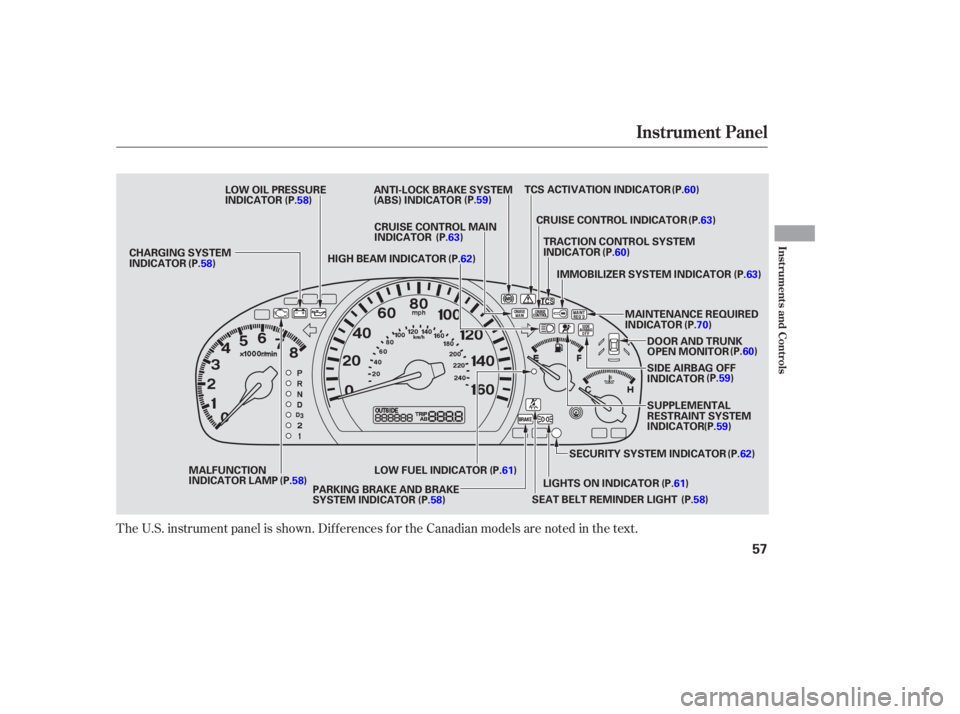
The U.S. instrument panel is shown. Dif f erences f or the Canadian models are noted in the text.
Instrument Panel
Inst rument s and Cont rols
57
CRUISE CONTROL INDICATOR
LOW FUEL INDICATOR MAINTENANCE REQUIRED
INDICATOR
MALFUNCTION
INDICATOR LAMP TRACTION CONTROL SYSTEM
INDICATOR
PARKING BRAKE AND BRAKE
SYSTEM INDICATOR TCS ACTIVATION INDICATOR
LOW OIL PRESSURE
INDICATOR
CHARGING SYSTEM
INDICATOR
SECURITY SYSTEM INDICATOR
IMMOBILIZER SYSTEM INDICATOR
ANTI-LOCK BRAKE SYSTEM
(ABS) INDICATOR
SUPPLEMENTAL
RESTRAINT SYSTEM
INDICATOR DOOR AND TRUNK
OPEN MONITOR
CRUISE CONTROL MAIN
INDICATOR
LIGHTS ON INDICATOR
HIGH BEAM INDICATOR
(P.70)
(P.58)
(P.58)
(P.58) (P.58)(P.61)
(P.61)
SEAT BELT REMINDER LIGHT (P.58) (P.62)
(P.
59)
(P. 59)
SIDE AIRBAG OFF
INDICATOR
(P.60)(P.63)
(P.60) (P.
63)
(P.
60)
(P. 59)
(P.63) (P.62)
Page 59 of 302
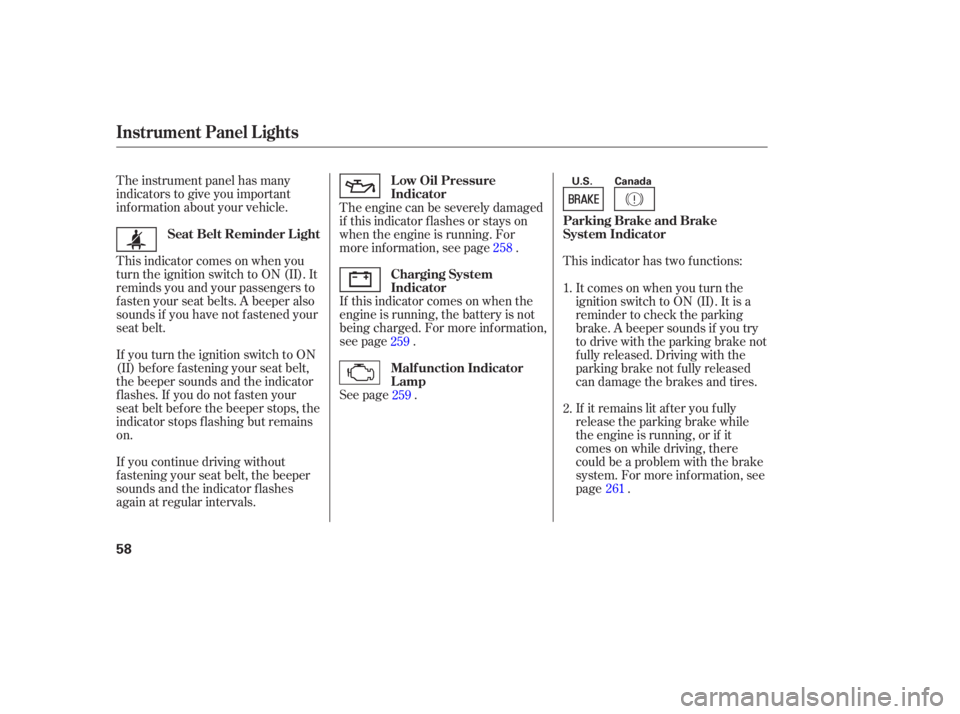
The instrument panel has many
indicators to give you important
inf ormation about your vehicle.If this indicator comes on when the
engine is running, the battery is not
being charged. For more inf ormation,
see page .
See page .This indicator has two f unctions:
This indicator comes on when you
turn the ignition switch to ON (II). It
reminds you and your passengers to
f asten your seat belts. A beeper also
sounds if you have not f astened your
seat belt.
If you turn the ignition switch to ON
(II) bef ore f astening your seat belt,
the beeper sounds and the indicator
f lashes. If you do not f asten your
seat belt bef ore the beeper stops, the
indicator stops f lashing but remains
on.
If you continue driving without
f astening your seat belt, the beeper
sounds and the indicator f lashes
again at regular intervals. Itcomesonwhenyouturnthe
ignition switch to ON (II). It is a
reminder to check the parking
brake. A beeper sounds if you try
to drive with the parking brake not
f ully released. Driving with the
parking brake not f ully released
can damage the brakes and tires.
If it remains lit af ter you f ully
release the parking brake while
the engine is running, or if it
comes on while driving, there
could be a problem with the brake
system. For more inf ormation, see
page .
The engine can be severely damaged
if this indicator f lashes or stays on
when the engine is running. For
more inf ormation, see page .
1.
2.
258
259 259
261
Instrument Panel L ights
Seat Belt Reminder L ight L ow Oil Pressure
Indicator
Charging System
Indicator
Malf unction Indicator
LampParking Brake and Brake
System Indicator
58
U.S. Canada
Page 60 of 302
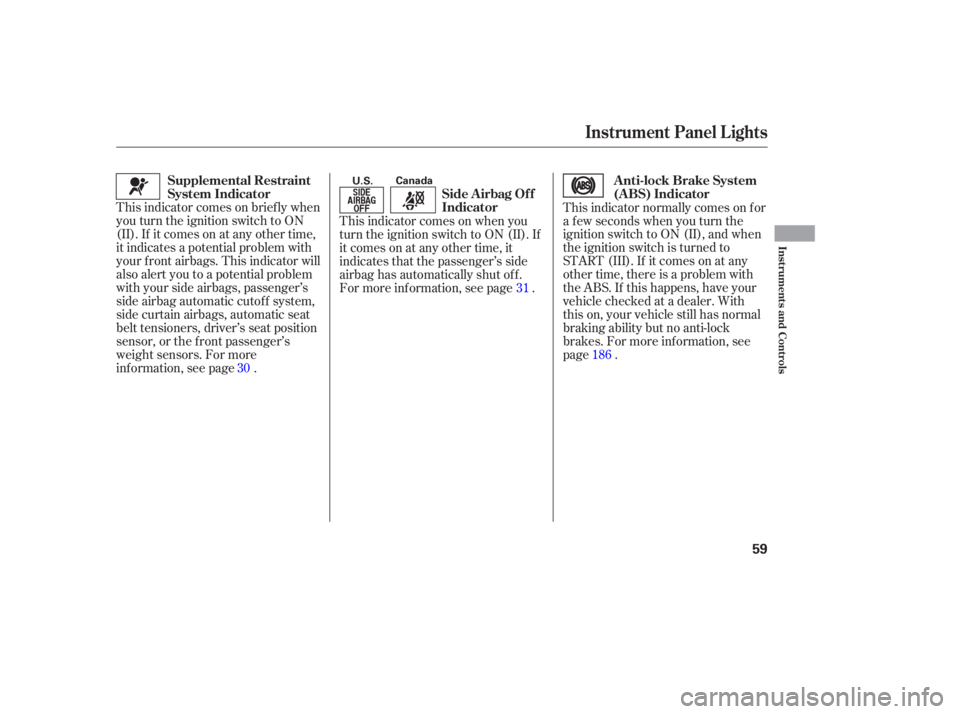
This indicator comes on brief ly when
you turn the ignition switch to ON
(II). If it comes on at any other time,
it indicates a potential problem with
your f ront airbags. This indicator will
also alert you to a potential problem
with your side airbags, passenger’s
side airbag automatic cutoff system,
side curtain airbags, automatic seat
belt tensioners, driver’s seat position
sensor, or the f ront passenger’s
weight sensors. For more
inf ormation, see page .This indicator normally comes on f or
a f ew seconds when you turn the
ignition switch to ON (II), and when
the ignition switch is turned to
START (III). If it comes on at any
other time, there is a problem with
theABS.If thishappens,haveyour
vehicle checked at a dealer. With
this on, your vehicle still has normal
braking ability but no anti-lock
brakes. For more inf ormation, see
page .
This indicator comes on when you
turn the ignition switch to ON (II). If
it comes on at any other time, it
indicates that the passenger’s side
airbag has automatically shut off.
For more inf ormation, see page .
30 186
31
Instrument Panel L ights
Supplemental Restraint
System Indicator
Anti-lock Brake System
(A BS) Indicator
Side A irbag Of f
Indicator
Inst rument s and Cont rols
59
U.S. Canada